Intel's Architecture Day 2018: The Future of Core, Intel GPUs, 10nm, and Hybrid x86
by Dr. Ian Cutress on December 12, 2018 9:00 AM EST- Posted in
- CPUs
- Memory
- Intel
- GPUs
- DRAM
- Architecture
- Microarchitecture
- Xe
The Next Generation Gen11 Graphics: Playable Games and Adaptive Sync!
Some of the first words out of the mouth of Raja Koduri about graphics is that Intel has a duty to its one billion customers with integrated graphics to give them something that is useful, and that it is time for Intel to provide graphics which people can actually play games on. Given his expertise on the matter, it shouldn’t sound too far-fetched: more people play games than ever before, and these users want to play no matter what their hardware. To that end, Raja stated that Gen11 graphics is the first step in a new graphics policy to provide the performance and features to let gamers play the most popular games, no matter what implementation.
Gen11: Intel’s first GT2 TFLOPS Graphics
In 2015, Intel launched the Skylake processor with Gen9 integrated graphics. Rather than moving straight to Gen10 the next time around, we were given Gen 9.5 in both Kaby Lake and Coffee Lake, which supposedly draw features from what would have been Gen 10. Actually, the graphics for Intel’s failed 10nm Cannon Lake chip were meant to be called Gen10, however Intel never released a Cannon Lake processor with working integrated graphics, and because Gen11 goes above and beyond what Gen10 would have been, we’ve gone straight to Gen11. Make sense? Well Intel didn’t even bother to acknowledge Gen10 in its history graph:
We will see Gen11 graphics being paired with Sunny Cove cores on 10nm sometime in 2019 according to the roadmaps. However rather than give a detailed architecture layout for the new product, we instead were given a rather high level diagram.
From here we can deduce a few things. We were told that this configuration is the GT2 config, which will have 64 execution units, up from 24 in Gen9.5. These 64 EUs are split into four slices, with each slice being made of two sub-slices of 8 EUs a piece. Each sub-slice will have an instruction cache and a 3D sampler, while the bigger slice gets two media samplers, a PixelFE, and additional load/store hardware. Intel lists Gen11 targeting efficiency, performance, advanced 3D and media capabilities, and a better gaming experience.
Intel didn’t go into too much detail regarding how the EUs are at higher performance, however the company did say that the FPU interfaces inside the EU are redesigned and it still has support for fast (2x) FP16 performance as seen in Gen9.5. Each EU will support seven threads as before, which means that the entire GT2 design will essentially have 512 concurrent pipelines. In order to help feed these pipes, Intel states that it has redesigned the memory interface, as well as increasing the L3 cache of the GPU to 3 MB, a 4x increase over Gen9.5, and it is now a separate block in the unslice section of the GPU.
Other features include tile-based rendering, which Intel stated the graphics hardware will be able to enable/disable on a render pass basis. This will make Intel the final member of the PC GPU vendor community to implement this, following NVIDIA in 2014 and AMD in 2017. While not a panacea to all performance woes, a good tile rendering setup plays well to the bandwidth limitations of an integrated GPU. Meanwhile Intel's lossless memory compression has also improved, with Intel listing a best case performance boost of 10% or a geometric mean boost of 4%. The GTI interface now supports 64 bytes per clock read and write to increase throughput, which works with the better memory interface.
Coarse Pixel Shading, Intel's implementation of multi-rate shading and similar in scope to NVIDIA’s own Variable Pixel Shading, is also supported. This allows the GPU to reduce the amount of total shading work required by shading some pixels on a less than 1:1 basis. Intel showed two demos for CPS, where pixel shading was reduced either as a function of object distance from camera (so you do less work when things are further away), or reduced as a function of how close the object is to the center of the screen, designed to help features like foveated rendering for VR. With a 2x2 pixel stencil applied – meaning only one pixel shading operation was done per block of 4 pixels – Intel stated a ~30% increase in frame rates in supported games. Unfortunately this needs to be applied on a game-by-game basis in order to prevent significant image quality losses, so the performance gains won't be immediate or universal.
For the media block, Intel says that the Gen11 design includes a ground up HEVC encoder design, with high quality encode and decode support. Intel cited the fact that its media fixed function units are already used in the datacenter for video processing, and home users can take advantage of the same hardware. Intel also stated that by using parallel decoders it can either support concurrent video streams or they can be combined to support a single large stream, and this scalable design will allow future hardware to push the peak resolutions up to 8K and beyond.
The highlight of the display engine is support for Adaptive Sync technologies. We were told that it was announced back at the launch of Skylake, but now it is finally ready to go into Intel’s integrated graphics. This goes in hand with HDR support due to its high-precision data path.
One thing in this presentation that Intel didn’t mention directly is that Gen11 graphics would appear to have Type-C video output support, potentially indicating that Intel has integrated the necessary mux into the chipset itself, removing another IC from the motherboard design.


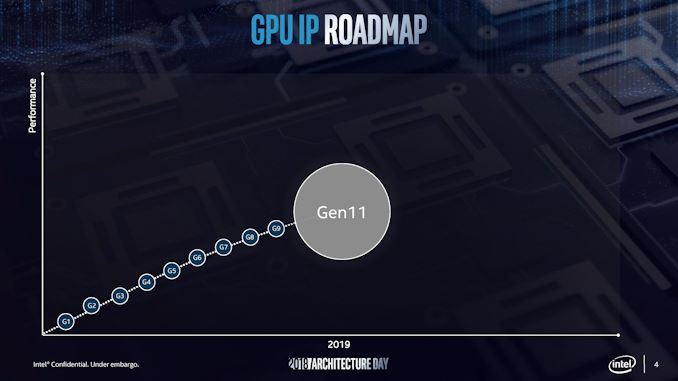
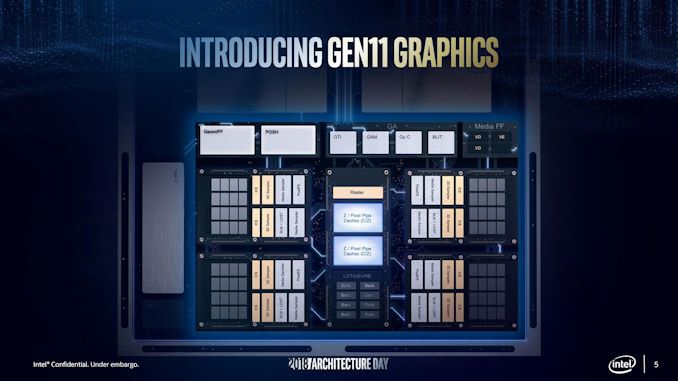
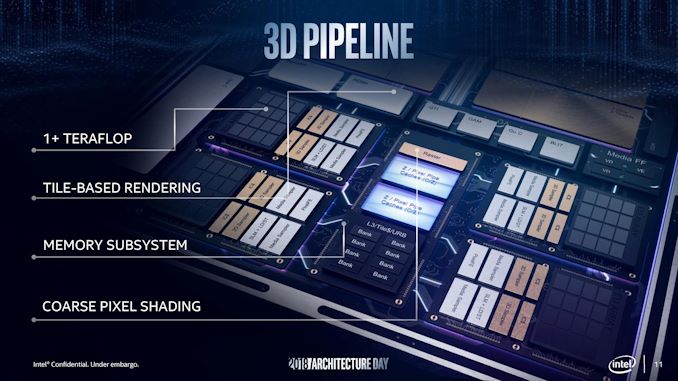
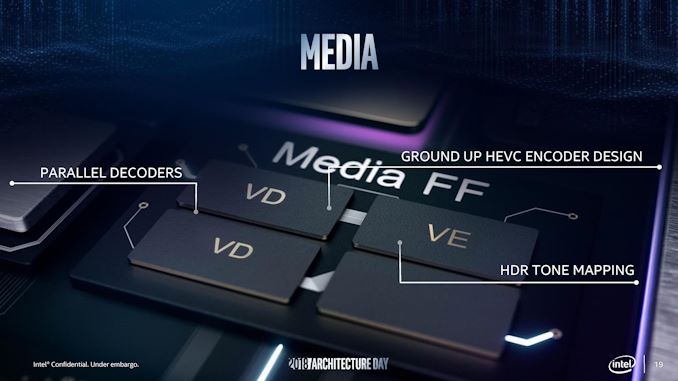
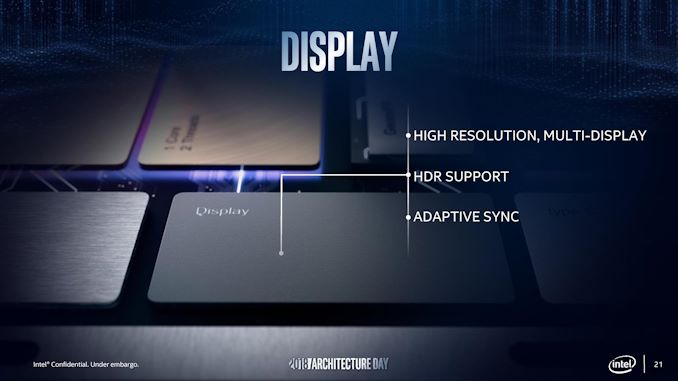
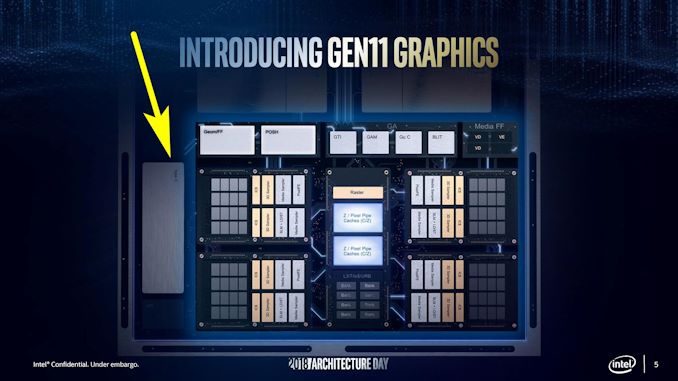








148 Comments
View All Comments
f1nalpr1m3 - Wednesday, December 12, 2018 - link
Yeah, they totally put it together in three weeks and everything.Get a clue.
pkgtech - Thursday, December 20, 2018 - link
For years Sohail Ahmed was the roadblock to Intel doing any creative package technology by blocking silicon support. He finally was shown for what he was after 2+ year process technology delays and re-invented this. Good riddance SohailAdonisds - Wednesday, December 12, 2018 - link
How do the Intel process delays influence their microarchitecture plans? 10 nm was already supposed to be here and with it its new microarchitecture, Ice Lake. Does the Ice Lake design continue to get improved as the delays kept happening or was it finalized years ago? Why? What about the microarchutectures succeeding Ice Lake?III-V - Wednesday, December 12, 2018 - link
This is Ice Lake. Might be a 14nm port (unclear at this point why the name change), but it's at the very least a close relative.III-V - Wednesday, December 12, 2018 - link
Actually, given the name on the heat sink, it is probably just straight up Ice LakeHStewart - Thursday, December 13, 2018 - link
I believe the road map states Ice Lake will be on 10nm. More importantly it will be on Sunny Cove which is significant update to Architexture.AdhesiveTeflon - Wednesday, December 12, 2018 - link
Intel and their naming scheme....they should call one "blue slushie lake"prisonerX - Wednesday, December 12, 2018 - link
Plans? Intel are in full scale panic mode right now. I'm sure they have new plans every week.jjj - Wednesday, December 12, 2018 - link
LOL you went in full fanboy mode with the 144mm package being small.The package is that size for PoP, the die is much much smaller, they can fit way more 10nm cores than that in such a large area, even without a base die.
Anyway, there are no relevant details on Foveros and that's problematic. The first question is cost, then you would want to know details about pitch and so on. Intel is by no means the first to announce such a solution so the details are what matters.
This is how you get to a 3D monolithic die in some years so any foundry that wants to stay in the most advanced node game, needs to push the packaging roadmap.
Ian Cutress - Wednesday, December 12, 2018 - link
I specifically said the package was small, and the die was smaller than the package.